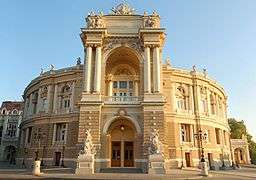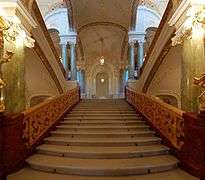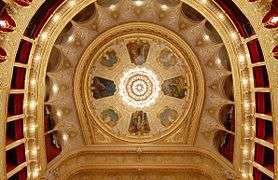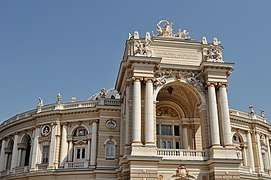Odessa Opera and Ballet Theater
The Odessa National Academic Theatre of Opera and Ballet (Ukrainian: Одеський національний академічний театр опери та балету) is the oldest theatre in Odessa, Ukraine. The Theatre and the Potemkin Stairs are the most famous edifices in Odessa.[1]
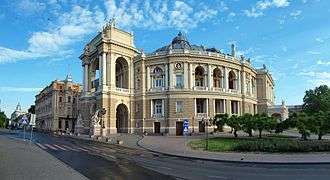 Odessa Theatre of Opera and Ballet | |

| |
| Address | 1 Tchaikovsky Street Odessa Ukraine |
|---|---|
| Coordinates | 46.485556°N 30.741667°E |
| Designation | Architectural Landmark |
| Capacity | 1,636 |
| Construction | |
| Opened | 1810 |
| Rebuilt | 1887, Fellner & Helmer |
| Website | |
| opera | |
The first opera house was opened in 1810 and destroyed by fire in 1873. The modern building was constructed by Fellner & Helmer in neo-baroque (Vienna Baroque) style and opened in 1887. The architecture of the luxurious audience hall follows the late French rococo style. The unique acoustics of the horseshoe-designed hall allows performers to deliver even a whisper-low tone of voice from the stage to any part of the hall. The most recent renovation of the theater was completed in 2007.
History
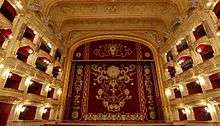
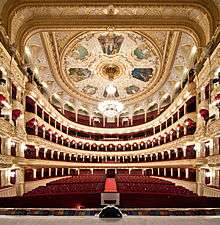
The Saint Petersburg architect Thomas de Thomon designed the first opera theatre, it opened on 10 February 1810. This last theatre is in almost exactly the same spot as the first theatre 200 years ago. The main entrance with its colonnade faced the sea. There was no foyer.[2][3]
In 1831, Michael Vorontsov, governor-general of Russian empire, Novorossia kray (currently part of Ukraine) decided to assign the old instituted quarantine fees to the Odessa Theatre.[4] Historian Charles King explains that one of the medical inspectors in Odessa was also the owner of the Odessa Theatre. When ticket sales were low, he would announce the discovery of an infection among newly arrived passengers and ordered them to be quarantined at their own cost. The expenses of the lazaretto, where the passengers that stayed would be used to hire a major performer for the theatre.[5]
On the night of 2 January 1873, the building was gutted by fire.[6]
A fund raising campaign began immediately. The city announced an international contest for the best theatre design. Forty designs were submitted, but none was chosen.[2][7] Finally, the project was drafted along the lines of Dresden Semperoper built in 1878, with its nontraditional foyer following the curvatures of auditorium.[8]
Two Viennese architects, Ferdinand Fellner and Hermann Helmer began to construct the larger replacement in 1883. The foundation stone was laid on 16 September 1884. On 1 October 1887 the theatre was completed, costing 1,300,000 rubles to build. It was named the Odessa City Theatre.[2][9][10][11]
The theatre was the first building in Odessa to employ the Edison Company with electric illumination.[12]
To keep theatre patrons comfortable in the summers, workers would lower waggonloads of ice and straw down a 35-foot shaft, then would carry it through a tunnel to a basement beneath the hall, where cool air rose up from vents beneath the seats.[11]
In 1925, the building was burnt again in a fire.[12] Fire team localized the burning, but the stage and orchestra pit were destroyed. During the fire of 1925, original curtain of the theater stage burned, which was never restored.[13]
There is a story that, when the Odessa people learned that the construction cost 1.3 million gold rubles, they gasped, but when they saw the new theatre, they gasped again, this time in admiration.[2]
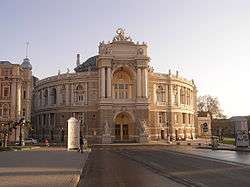
In August 1941, when the Romanian army was dangerously close to Odessa, the command of the Odessa defensive area appointed a special anti-aircraft unit, which was given the task of protecting the theater building from bombing. On the roofs of the houses adjacent to the theater, guns were installed that shot all 73 days of the city defending.[14] During World War II, Nikita Khrushchev, concerned about the condition of the city, visited Odessa immediately after it was liberated. Khrushchev reported that only one corner of the building had been damaged by an enemy shell.[15]
The theatre was remodelled in the 1960s.[12]
The theatre sits upon shifting ground and is in danger of collapse. The first cracks in the foundation appeared almost as soon as the theatre opened. The theatre's eastern half sagged almost seven inches in its first three years, and the six walls began to tilt. Gleb Dranov, a former opera singer who sang at the theatre for 25 years, and who worked five years as a geologist, is helping repair the building.[11][12]
Construction
The building's façade is decorated in the Italian baroque style. In the niches are the busts of Mikhail Glinka, Nikolai Gogol, Alexandr Griboyedov and Alexander Pushkin. The large hall was modelled after the style of Louis XVI, and is richly decorated with gilded stucco figures and designs. The architects provided the foyer with twenty-four exits, to avoid tragedy in the case of a fire. On the side of the theatre is a lawn with fresh flowers and shrubs.[9]
People
The famous Russian singer Feodor Chaliapin gave many concerts at the Odessa Opera.
Gallery
See also
References
Notes
- Iljine, Nicholas V., ed. (2004). Odessa Memories. essay by Patricia Herlihy; contributions by Bel Kaufman, Oleg Gubar, and Alexander Rozenboim. Seattle: University of Washington Press. p. 13. ISBN 0-295-98345-0.
- Kononova, G. (1984). Odessa: A Guide. Moscow: Raduga Publishers. Archived from the original on 2007-09-28. p. 67
- Karakina, p. 68 Lists the architect's name as Toma de Tomana.
- Anthony L.H. Rhinelander. (1990). Prince Michael Vorontsov: Viceroy to the Tsar. McGill-Queen's Press - MQUP. ISBN 0-7735-0747-7. p. 110
- King, Charles (2004). The Black Sea: A History. Oxford University Press: Oxford University Press. ISBN 0-19-924161-9. p. 171
- Karakina, Yelena; Tatyana Samoilova; Anna Ishchenko (2004). Touring Odessa. BDRUK. ISBN 966-8137-01-9. Archived from the original on 2009-09-07. p. 67
- Karakina, p. 67 States: There were forty three entrants, and...Felner and Gelmer were selected.
- Buildings for Music, Michael Forsythe, Cambridge University Press, p. 344
- Herlihy, Patricia (1991) [1987]. Odessa: A History, 1794-1914. Cambridge, MA: Harvard University Press. ISBN 0-916458-15-6. p. 266-7
- Karakina, p. 70 States: The Opera and Ballet Theatre acquired its name in the early 20th century. When first created, it was simply called the City Theatre.
- Wines, Michael (November 1, 1999). "An Aged Beauty Gets a Facelift From a Geologist". The New York Times: 4. Archived from the original on September 28, 2007.
- Kaufman, p. 14.
- "Odessaguide: attractions". Odessa Opera House. 2019.
- "Archodessa". Odessa Opera House in the Second World War. 2014.
- Khrushchev, Nikita (2004). Sergei Khrushchev (ed.). Memoirs of Nikita Khrushchev: The Commissar, 1918-1945. Penn State Press: Pennsylvania State University. ISBN 0-271-02332-5. p. 597
External links
- "Official website of the Odessa National Academic Opera and Ballet Theatre". Retrieved 2018-10-27.
- "Odessa Opera Theatre". Archived from the original on 2007-09-28. Retrieved 2006-08-03.
- "Odessa urges political parties to finance theatre restoration". TASS. January 18, 2006. Archived from the original on September 28, 2007.
- Wines, Michael (November 1, 1999). "An Aged Beauty Gets a Facelift From a Geologist". The New York Times: 4. Archived from the original on September 28, 2007.
| Wikimedia Commons has media related to Odessa Opera Theatre. |
